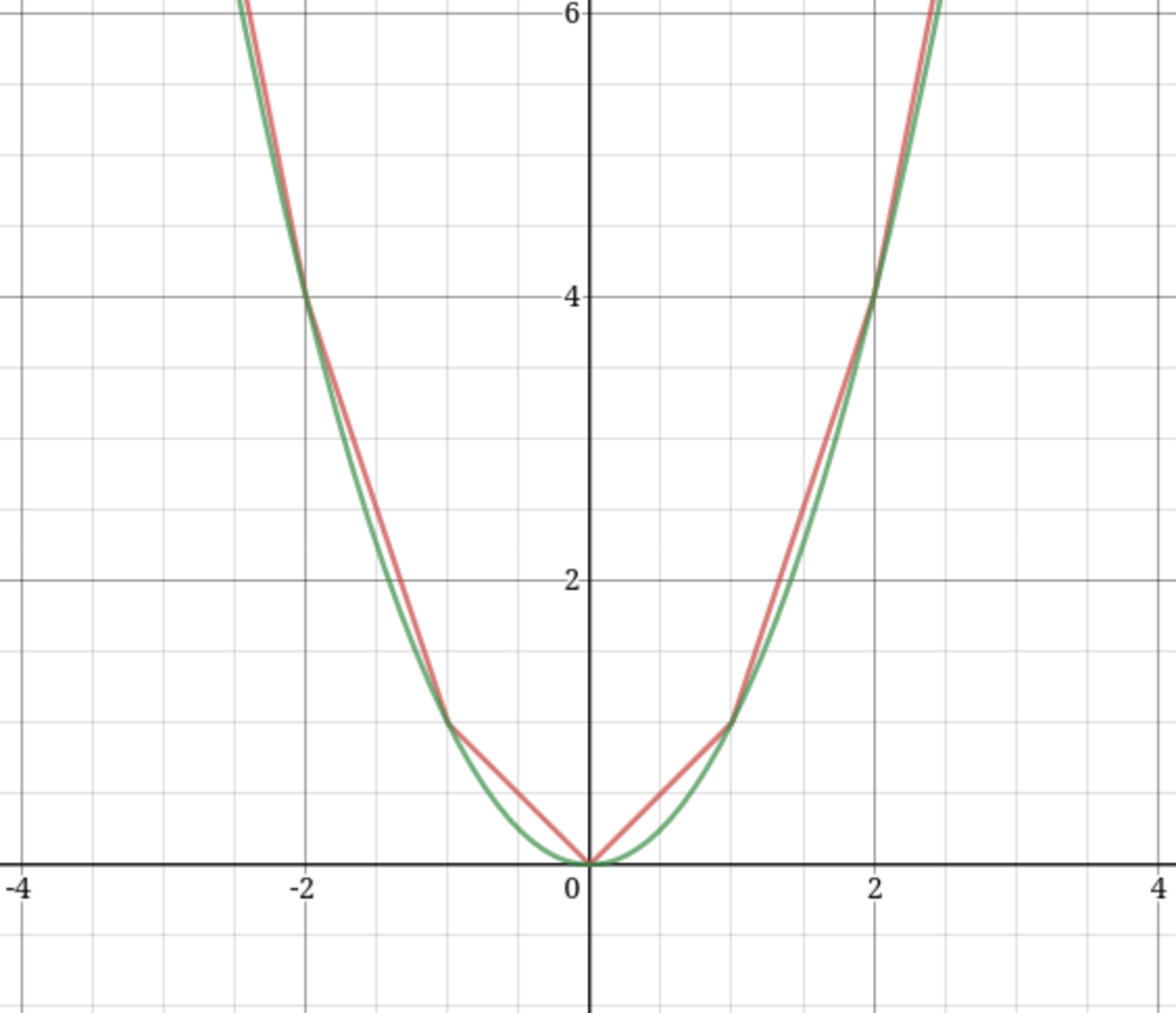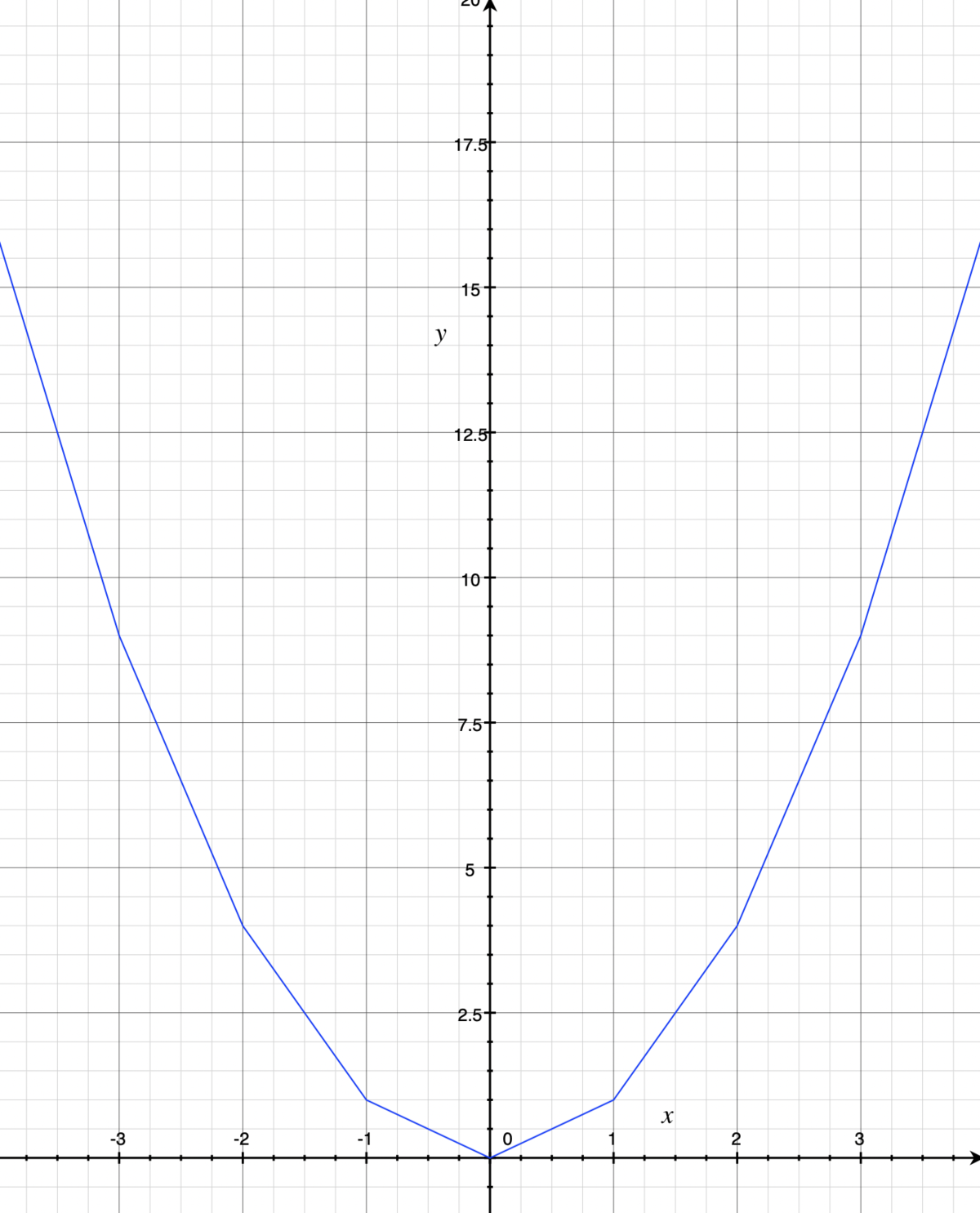Absolutely interesting limit
We can define a family of real functions g n so that, for instance, g 3 ( x ) = ∣ x − 3 ∣ + ∣ x − 2 ∣ + ∣ x − 1 ∣ + ∣ x ∣ + ∣ x + 1 ∣ + ∣ x + 2 ∣ + ∣ x + 3 ∣ , and more generally for integers n ≥ 0 , g n ( x ) = k = − n ∑ n ∣ x + k ∣ . Now let f ( x ) = n → ∞ lim ( g n ( x ) − n ( n + 1 ) ) . Evaluate f ( 7 . 2 ) .
Hint : For integer values of x , f ( x ) turns out to be a familiar function.
The answer is 52.
This section requires Javascript.
You are seeing this because something didn't load right. We suggest you, (a) try
refreshing the page, (b) enabling javascript if it is disabled on your browser and,
finally, (c)
loading the
non-javascript version of this page
. We're sorry about the hassle.
2 solutions
There is no need for linear interpolation. f ( x ) = ( 2 ⌊ x ⌋ + 1 ) x − ⌊ x ⌋ ( ⌊ x ⌋ + 1 )
Hello, I arrived at a different solution when solving this specific case. What I did was remove the absolute value as follows:
[ n − 7 . 2 ] + [ ( n − 1 ) − 7 . 2 ] + . . . + [ 9 − 7 . 2 ] + [ 8 − 7 . 2 ] + [ 7 . 2 − 7 ] + . . . + [ 7 . 2 − 1 ] + 7 . 2 + k = 1 ∑ n ( 7 . 2 + k )
Here, we can clearly see that we can collect all the integers like this: n ( n + 1 ) − 2 8 ; and, after some algebra, we will get 7 . 2 ( 1 5 ) . With this in mind and without any rigorous proof, I intuitively arrived at the general formula f ( x ) = ( 2 ⌊ x ⌋ + 1 ) x − 2 ⌊ x ⌋ ( ⌊ x ⌋ + 1 ) .
However, when doing a rigorous proof and checking the answers posted for this problem the formula is: f ( x ) = ( 2 ⌊ x ⌋ + 1 ) x − ⌊ x ⌋ ( ⌊ x ⌋ + 1 ) . I have spent some time thinking about it but I can't wrap my head around it since I believe I didn't make any mistakes in my first solution, where the answer is 80 instead of 52.
I think something goes wrong when you collect the integers. The first few terms (up to [ 8 − 7 . 2 ] ) give n + ( n − 1 ) + ( n − 2 ) + ⋯ + 8 = 2 1 n ( n + 1 ) − 2 8 ; the next few terms give ( − 7 ) + ( − 6 ) + ⋯ + ( − 1 ) = − 2 8 ; the last terms are k = 1 ∑ n k = 2 1 n ( n + 1 ) . The total, then, is ( 2 1 n ( n + 1 ) − 2 8 ) + ( − 2 8 ) + 2 1 n ( n + 1 ) = n ( n + 1 ) − 5 6 . I suspect that you forgot to add in one of the − 2 8 terms when adding?
For x ≥ n ,
g n ( x ) = k = − n ∑ n ∣ x + k ∣ = k = − n ∑ n ( x + k ) = k = − n ∑ n x + k = − n ∑ n k = ( 2 n + 1 ) x
Similarly, for x ≤ − n , g n ( x ) = − ( 2 n + 1 ) x
But, the case we're most interested in is − n < x < n . From the definition of the floor function, ⌊ x ⌋ ≤ x < ⌊ x ⌋ + 1 . For legibility and ease, we'll use j = ⌊ x ⌋ throughout the solution.
g n ( x ) = k = − n ∑ n ∣ x + k ∣ = k = − n ∑ − j − 1 ∣ x + k ∣ + k = − j ∑ n ∣ x + k ∣ = − k = − n ∑ − j − 1 ( x + k ) + k = − j ∑ n ( x + k ) = − k = − n ∑ − j − 1 x − k = − n ∑ − j − 1 k + k = − j ∑ n x + k = − j ∑ n k = − ( n − j ) x − 2 j ( j + 1 ) + 2 n ( n + 1 ) + ( n + j + 1 ) x − 2 j ( j + 1 ) + 2 n ( n + 1 ) = ( 2 j + 1 ) x − j ( j + 1 ) + n ( n + 1 )
So, f ( x ) ⟹ f ( x ) = n → ∞ lim ( g n ( x ) − n ( n + 1 ) ) = n → ∞ lim ( ( 2 j + 1 ) x − j ( j + 1 ) + n ( n + 1 ) − n ( n + 1 ) ) = n → ∞ lim ( ( 2 j + 1 ) x − j ( j + 1 ) ) = ( 2 j + 1 ) x − j ( j + 1 ) = ( 2 ⌊ x ⌋ + 1 ) x − ⌊ x ⌋ ( ⌊ x ⌋ + 1 )
It's interesting to note that f ( x ) and x 2 touch when x is an integer.
 Fig: f(x) in red and x^2 in green
Fig: f(x) in red and x^2 in green
Lastly, f ( 7 . 2 ) = ( 2 × 7 + 1 ) 7 . 2 − 7 ( 7 + 1 ) = 5 2
By writing x = ⌊ x ⌋ + { x } (so that 0 ≤ { x } < 1 is the fractional part of x ), you can further simplify to f ( x ) = ( 2 ⌊ x ⌋ + 1 ) ( ⌊ x ⌋ + { x } ) − ⌊ x ⌋ ( ⌊ x ⌋ + 1 ) = ⌊ x ⌋ 2 + ( 2 ⌊ x ⌋ + 1 ) { x } , which describes the linear extrapolation, especially if you consider that 2 ⌊ x ⌋ + 1 = ⌊ x + 1 ⌋ 2 − ⌊ x ⌋ 2 .
Log in to reply
Yes. If we use floor, ceiling, and fractional functions, we can also write it as f ( x ) = ⌊ x ⌋ 2 + ( ⌈ x ⌉ 2 − ⌊ x ⌋ 2 ) { x }
Log in to reply
That is pretty.
Or, more symmetrically f ( x ) = ⌊ x ⌋ 2 ( ⌈ x ⌉ − x ) + ⌈ x ⌉ 2 ( x − ⌊ x ⌋ ) .
It turns out that for integer values of x , f ( x ) = x 2 . You can easily check this with a few examples; I will also prove it below.
Also, each of the functions in the problem is piecewise linear; to be precise, linear on each interval [ k , k + 1 ] between successive integers.
Thus the solution point lies on the line segment between ( 7 , 4 9 ) and ( 8 , 6 4 ) , which has a slope of 15. Thus f ( 7 . 2 ) = 4 9 + 0 . 2 × 1 5 = 5 2 .
Proof that f ( x ) = x 2 for integer values of x :
Let x be an integer such that − n ≤ x ≤ n , g n ( x ) = ( n − x ) + ( n − x − 1 ) + ⋯ + 2 + 1 + 0 + 1 + 2 + ⋯ + ( n + x ) = ( 1 + 2 + ⋯ + ( n − x ) ) + ( 1 + 2 + ⋯ + ( n + x ) ) = 2 1 ( n − x ) ( n − x + 1 ) + 2 1 ( n + x ) ( n + x + 1 ) = 2 1 ( n 2 + x 2 − 2 n x + n − x ) + 2 1 ( n 2 + x 2 + 2 n x + n + x ) = n 2 + x 2 + n = x 2 + n ( n + 1 ) . Therefore, for all − n ≤ x ≤ n , g n ( x ) − n ( n + 1 ) = x 2 , and since by taking the limit we always accomplish n ≥ x in the end, this means that f ( x ) = x 2 .